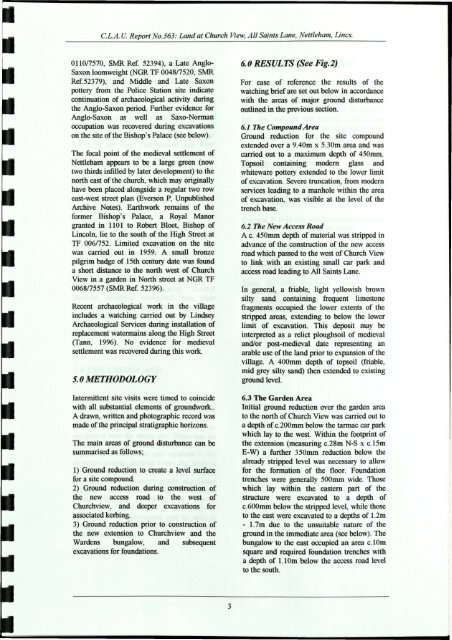land at church view, all saints lane, nettleham, lincs. - Archaeology ...
land at church view, all saints lane, nettleham, lincs. - Archaeology ...
land at church view, all saints lane, nettleham, lincs. - Archaeology ...
You also want an ePaper? Increase the reach of your titles
YUMPU automatically turns print PDFs into web optimized ePapers that Google loves.
C.L.A. U. Report No.363: Land <strong>at</strong> Church View, All Saints Lane, Nettleham, Lines.<br />
0110/7570, SMR Ref. 52394), a L<strong>at</strong>e Anglo-<br />
Saxon loomweight (NGR TF 0048/7520, SMR<br />
Ref. 52379), and Middle and L<strong>at</strong>e Saxon<br />
pottery from the Police St<strong>at</strong>ion site indic<strong>at</strong>e<br />
continu<strong>at</strong>ion of archaeological activity during<br />
the Anglo-Saxon period. Further evidence for<br />
Anglo-Saxon as well as Saxo-Norman<br />
occup<strong>at</strong>ion was recovered during excav<strong>at</strong>ions<br />
on the site of the Bishop's Palace (see below).<br />
The focal point of the medieval settlement of<br />
Nettleham appears to be a large green (now<br />
two thirds infilled by l<strong>at</strong>er development) to the<br />
north east of the <strong>church</strong>, which may origin<strong>all</strong>y<br />
have been placed alongside a regular two row<br />
east-west street plan (Everson P, Unpublished<br />
Archive Notes). Earthwork remains of the<br />
former Bishop's Palace, a Royal Manor<br />
granted in 1101 to Robert Bloet, Bishop of<br />
Lincoln, lie to the south of the High Street <strong>at</strong><br />
TF 006/752. Limited excav<strong>at</strong>ion on the site<br />
was carried out in 1959. A sm<strong>all</strong> bronze<br />
pilgrim badge of 15th century d<strong>at</strong>e was found<br />
a short distance to the north west of Church<br />
View in a garden in North street <strong>at</strong> NGR TF<br />
0068/7557 (SMR Ref. 52396).<br />
Recent archaeological work in the village<br />
includes a w<strong>at</strong>ching carried out by Lindsey<br />
Archaeological Services during inst<strong>all</strong><strong>at</strong>ion of<br />
replacement w<strong>at</strong>ermains along the High Street<br />
(Tann, 1996). No evidence for medieval<br />
settlement was recovered during this work.<br />
5.0 METHODOLOGY<br />
Intermittent site visits were timed to coincide<br />
with <strong>all</strong> substantial elements of groundwork..<br />
A drawn, written and photographic record was<br />
made of the principal str<strong>at</strong>igraphic horizons.<br />
The main areas of ground disturbance can be<br />
summarised as follows;<br />
1) Ground reduction to cre<strong>at</strong>e a level surface<br />
for a site compound.<br />
2) Ground reduction during construction of<br />
the new access road to the west of<br />
Church<strong>view</strong>, and deeper excav<strong>at</strong>ions for<br />
associ<strong>at</strong>ed kerbing.<br />
3) Ground reduction prior to construction of<br />
the new extension to Church<strong>view</strong> and the<br />
Wardens bungalow, and subsequent<br />
excav<strong>at</strong>ions for found<strong>at</strong>ions.<br />
3<br />
6.0 RESULTS (See Fig.2)<br />
For ease of reference the results of the<br />
w<strong>at</strong>ching brief are set out below in accordance<br />
with the areas of major ground disturbance<br />
outlined in the previous section.<br />
6.1 The Compound Area<br />
Ground reduction for the site compound<br />
extended over a 9.40m x 5.30m area and was<br />
carried out to a maximum depth of 450mm.<br />
Topsoil containing modern glass and<br />
whiteware pottery extended to the lower limit<br />
of excav<strong>at</strong>ion. Severe trunc<strong>at</strong>ion, from modern<br />
services leading to a manhole within the area<br />
of excav<strong>at</strong>ion, was visible <strong>at</strong> the level of the<br />
trench base.<br />
6.2 The New Access Road<br />
A c. 450mm depth of m<strong>at</strong>erial was stripped in<br />
advance of the construction of the new access<br />
road which passed to the west of Church View<br />
to link with an existing sm<strong>all</strong> car park and<br />
access road leading to All Saints Lane.<br />
In general, a friable, light yellowish brown<br />
silty sand containing frequent limestone<br />
fragments occupied the lower extents of the<br />
stripped areas, extending to below the lower<br />
limit of excav<strong>at</strong>ion. This deposit may be<br />
interpreted as a relict ploughsoil of medieval<br />
and/or post-medieval d<strong>at</strong>e representing an<br />
arable use of the <strong>land</strong> prior to expansion of the<br />
village. A 400mm depth of topsoil (friable,<br />
mid grey silty sand) then extended to existing<br />
ground level.<br />
6.3 The Garden Area<br />
Initial ground reduction over the garden area<br />
to the north of Church View was carried out to<br />
a depth of c.200mm below the tarmac car park<br />
which lay to the west. Within the footprint of<br />
the extension (measuring c.28m N-S x c.l5m<br />
E-W) a further 350mm reduction below the<br />
already stripped level was necessary to <strong>all</strong>ow<br />
for the form<strong>at</strong>ion of the floor. Found<strong>at</strong>ion<br />
trenches were gener<strong>all</strong>y 500mm wide. Those<br />
which lay within the eastern part of the<br />
structure were excav<strong>at</strong>ed to a depth of<br />
c.600mm below the stripped level, while those<br />
to the east were excav<strong>at</strong>ed to a depths of 1.2m<br />
- 1.7m due to the unsuitable n<strong>at</strong>ure of the<br />
ground in the immedi<strong>at</strong>e area (see below). The<br />
bungalow to the east occupied an area c.lOm<br />
square and required found<strong>at</strong>ion trenches with<br />
a depth of 1.10m below the access road level<br />
to the south.

















